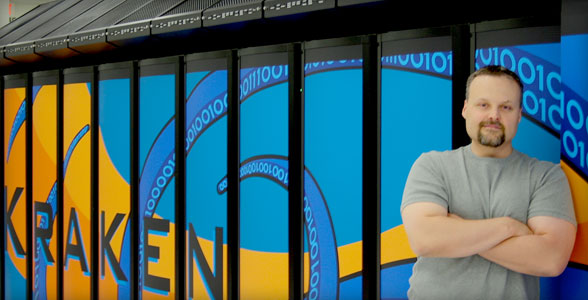By David Smith
To understand the gist of what Bronson Messer and his fellow astrophysicists are studying, a Nerf ball helps. But to better understand a core-collapse supernova and its effects you’re going to need the most powerful academic supercomputer on the planet. The University of Tennessee happens to have that.
Messer received both his bachelor’s and Ph.D. in physics from UT Knoxville. He currently runs simulations of core-collapse supernovae on Kraken, the UT supercomputer housed in the National Institute for Computational Sciences at Oak Ridge National Laboratory.
The National Science Foundation awarded $65 million to UT in 2008 to build a supercomputer. In early 2009, the supercomputer, named Kraken after a mythical sea monster, ran at full capacity for the first time.
When the June 2009 edition of the Top500 list came out – the globally recognized rankings for supercomputers – Kraken ranked as the fastest university-managed supercomputer in the world and sixth fastest overall.
Being so powerful, Kraken is ideally suited to, say, describing and decoding the biggest explosions in the Universe. Enter Bronson Messer; space-time left.
The sun will likely “die” after 10 billion years, Messer said. But a star 25 times the mass of the sun burns all of its hydrogen quickly, in roughly 7 million years, he said. “The star burns through helium and other elements, and then it gets to iron, and it’s screwed.
“It reaches a point where it can’t hold itself up against its own gravity,” he said. “It’s like taking a Nerf ball in your hands and collapsing it down. It rebounds into your hands, so that bounce shock is what eventually is going to rip the star apart.” Voila, a core-collapse supernova. If a star as close to Earth as the red star Betelgeuse in Orion’s arm were to do this, it would be visible during the day for weeks and brighter than the full moon for month, he said.
“Once we understand how they blow up, then we can do things like predict how much stuff comes out of the event,” Messer said. “That gives us some notion of how our solar system formed because our solar system came from the ashes of a previous generation of stars. What’s really important scientifically, other than it’s a really big explosion, is that all the iron in our blood, all the gold around our neck, all the silicon in the sand in every pebble on Earth was either born or disseminated in a supernova explosion.”
Messer and his collaborators on core-collapse supernovae run simulations on Kraken, pumping the supercomputer full of algorithms to model how conditions behave. Kraken is around precisely to tackle these types of massively complicated problems, such as climate change, how to best break down material and convert it into biofuels, and earthquake simulations.
Kraken is a tool, a very large tool, said Thom Mason, director of Oak Ridge National Laboratory. Some scientific problems can’t be solved simply or elegantly and “you need brute force to crack it.”
“Another approach is to just go out with the biggest mallet you got, and model it,” Mason said. “There’s a whole set of areas where there’s many constituents to the problem, many degrees of freedom so intrinsic, you’re going to need a computer with many, many (central processing units), and lots of memory and a very high compute rate in order to computationally solve that problem.”
Having the biggest “university-managed” tool in the shed is growing UT’s reputation worldwide, said Thomas Zacharia, deputy director of science and technology at ORNL and former vice president at UT.
“Just two years ago nobody associated UT with computing,” Zacharia said. “Today, the world over, everybody knows UT and ORNL about supercomputing.”
And with Kraken being so powerful, UT can continue momentum that has made it “better than it has ever been,” said UT Interim President Jan Simek after the Top500 list was released.
“Having the fastest university-managed supercomputer in the world allows UT to keep getting better, and Kraken is another tool that helps us attract the best students, the best researchers, and the best professors, something every university strives for,” Simek said.
It certainly attracted Messer, who was running his simulations on “Ranger,” a supercomputer in Texas, before he moved his work to Kraken in 2008.
“I wasn’t just being a homer,” Messer said. “It’s just that Kraken, for the kind of simulations we wanted to do, was much more capable.”
And the value of Kraken reaches down to the undergraduate level. “There’s not many places – period — where if you’re an undergraduate or graduate student that you can learn high performance computing, because it’s still very much an apprenticeship,” Messer said.
“You sort of have to go to the mountain and, well, Kraken is one of those mountains now.”



